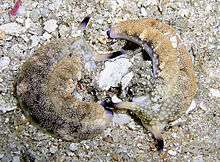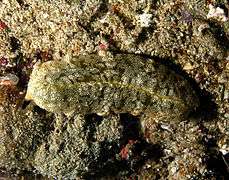Plakobranchus ocellatus
| Plakobranchus ocellatus | |
|---|---|
 | |
| Two Plakobranchus ocellatus seaslugs facing in opposite directions | |
| Scientific classification | |
| Kingdom: | Animalia |
| Phylum: | Mollusca |
| Class: | Gastropoda |
| (unranked): | clade Heterobranchia informal group Opisthobranchia |
| Superfamily: | Plakobranchoidea |
| Family: | Plakobranchidae |
| Genus: | Plakobranchus |
| Species: | P. ocellatus |
| Binomial name | |
| Plakobranchus ocellatus (van Hasselt, 1824) | |
| Synonyms | |
| |
Plakobranchus ocellatus is a species of sea slug, a sacoglossan, a marine opisthobranch gastropod mollusk in the family Plakobranchidae. [1]

Distribution
This species occurs in the Indo-Pacific.[1] Recent work on the photosynthetic abilities of Plakobranchus reveals that P. ocellatus is actually a species complex consisting of at least four distinct clades.[2]
Description
The body is broad, truncate, and rather flattened, up to 4 cm long.[1] The ground colour is usually pale green, beige, or cream with large ocelli (spots similar to eyespots) of cream, brown, pink, and purple in varying shades.[1] The sole of the foot also has ocelli.[1]
 Dorsal view of a freshly collected intact Plakobranchus ocellatus showing its head, rhinophores and parapodia. |
 Dorsal view of an anesthetized individual of Plakobranchus ocellatus with spread parapodia. Stomach and branched digestive glands are visible. The tissue region in the red square was dissected and used for DNA extraction in the study by Maeda T. et al. (2012).[3] |
Habitat
These seaslugs live in sheltered, shallow water habitats with stones or gravel and silt.[1] They feed on a broad food spectrum, including members of the genera Halimeda, Caulerpa, Udotea, Acetabularia and further unidentified algae, with an emphasis on Halimeda macroloba.[2]
References
This article incorporates CC-BY-3.0 text from the reference.[1]
- 1 2 3 4 5 6 7 Gofas, S. (2014). Plakobranchus ocellatus van Hasselt, 1824. Accessed through: World Register of Marine Species on 2014-11-08
- 1 2 Christa G., Wescott L., Schäberle T.F., König G.M., Wägele H., (2013) What remains after 2 months of starvation? Analysis of sequestered algae in a photosynthetic slug, Plakobranchus ocellatus (Sacoglossa, Opisthobranchia), by barcoding. Planta. Feb;237(2):559-72. doi: 10.1007/s00425-012-1788-6. Epub 2012 Oct 30.
- ↑ Maeda T., Hirose E., Chikaraishi Y., Kawato M., Takishita K. et al. (2012). "Algivore or Phototroph? Plakobranchus ocellatus (Gastropoda) Continuously Acquires Kleptoplasts and Nutrition from Multiple Algal Species in Nature". PLoS ONE 7(7): e42024. doi:10.1371/journal.pone.0042024
- Jensen K.R. (2007) Biogeography of the Sacoglossa (Mollusca, Opisthobranchia). Bonner Zoologische Beiträge 55:255–281
External links
| Wikimedia Commons has media related to Plakobranchus ocellatus. |
